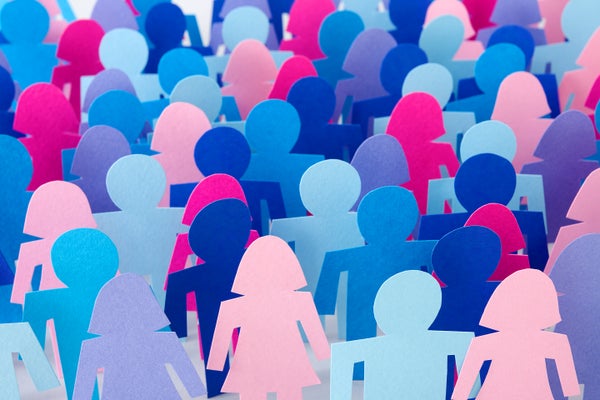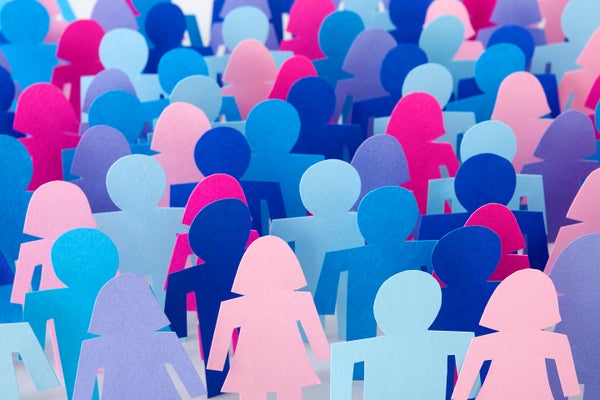Sex and Gender Map onto Different Brain Networks in Children
A preliminary study suggests that sex and gender are represented differently in the brain

FotografiaBasica/Getty Images
A new brain-imaging study of young adolescents has shown that sex and gender map onto different brain networks. The findings, published on Friday in Science Advances, demonstrate the importance of considering the social impact of gender in neuroscience research rather than conflating it with physiological sex.
“Moving forward, we really need to consider both sex and gender separately if we want to better understand the brain,” said study co-author Elvisha Dhamala, a neuroscientist at the Feinstein Institutes for Medical Research, in a recent press conference.
Physiological sex is largely determined by chromosomes, genes, hormones and other biological systems. On top of that, cultural ideas about what it means to be, for example, a man, woman or nonbinary person—what we call gender—also play a critical role shaping people’s life and behavior. Scientists understand sex and gender to be related yet distinct concepts, but they are often conflated in neuroscience research. This means that differences between the brains of people who are assigned male or female at birth are often taken as reflections of biological differences when they could very well be the result of how each group is treated based on cultural expectations.
On supporting science journalism
If you’re enjoying this article, consider supporting our award-winning journalism by subscribing. By purchasing a subscription you are helping to ensure the future of impactful stories about the discoveries and ideas shaping our world today.
“The influence of being treated as a woman or as a man in our society is ignored” in neuroscience research, says Lara M. Wierenga, a neuroscientist who studies gender differences in brain development at Leiden University in the Netherlands and was not involved in the new research. “But we also know that the brain is very plastic, very open to experiences,” which can differ greatly between people assigned female or male at birth, she says.
For the new study, Dhamala’s team wanted to know what the field might be missing by ignoring the social impact of gender. The researchers worked with data from a large and ongoing longitudinal study of U.S. adolescents to compare brain scan data with questionnaire responses about the participants’ sex and gender from them and their parents.
While the researchers expected sex to be associated with differences in activity in certain brain networks, beyond that, “we had no idea whether or not [gender] would map onto the brain and also no idea where it would map onto the brain,” Dhamala says.
The study researchers analyzed functional magnetic resonance imaging (fMRI) data from 4,757 children aged nine or 10 years old. The fMRI scanner captured “resting-state” activity across different brain regions that occurs when someone is awake but not engaged in a specific task. The young participants had also been asked four questions about their feelings about their gender (such as “How much do you feel like a boy?”), and their parents had been asked 12 questions about how their child talked about their gender and how they engaged in play activities that are stereotypically “for boys” or “for girls.”
The researchers fed the brain-scan data, along with information about each participant’s sex, into a machine-learning model, which learned to pick out subtle differences in the activity of certain regions of the brain between the male and female groups. Then they tested the model on data it had not yet seen by asking it to predict participants’ sex based on their brain scans, which it accomplished with 77 percent accuracy.
Next, the researchers went on to train another machine-learning model to make predictions from the preteens’ and parents’ reports about gender. But because sex and gender are so strongly related to each other, the brain networks associated with each largely overlapped. To bring gender into clearer view, the team analyzed the participants’ gender variation separately by sex. This showed how and where brain activity differed between people who had been assigned the same sex at birth but had varying feelings and expression of their gender.
Finally, the researchers compared the networks associated with gender differences with those associated with sex differences. They found that while there was some overlap, these groups of networks were largely different from one another, though this difference was only statistically significant for the parent-reported gender data, not the self-reports. (The study authors think the self-report questionnaire was not sensitive enough to capture differences in how children think and feel about their gender.)
The brain networks unique to sex but not gender included networks with more well-defined roles in the brain, such as the visual network and motor network. Conversely, the networks that showed gender but not sex differences were more dispersed throughout the brain. It’s too soon to draw conclusions about why some networks were associated with sex and not gender and vice versa, Dhamala says: “We have no idea right now” if those differences relate to differences in behavior.
“This is really the first time that it’s shown in such a large dataset that not only sex but also gender is related to the way the brain is wired,” Wierenga says. “The expectations that we have [based on gender], they do matter.” This is important to understand because gender-related differences in the brain could impact how psychiatric disorders manifest across the gender spectrum, especially those that are underdiagnosed in people who were assigned female at birth (such as attention-deficit hyperactivity disorder, or ADHD) or who were assigned male (such as anxiety and mood disorders), Wierenga says.
Because the research was only done in children, it’s also not clear whether gender would map onto the brain differently from sex in adults, though Wierenga says she expects that this pattern would hold.
Dhamala’s team plans to rerun similar analyses on the same group of children as they grow. “These are still very young kids. And as they go through adolescence and into adulthood, their brain networks and their functional connectivity is going to be changing,” she says. In the meantime, the researchers say, other teams could begin testing gender as well as sex in their research to yield a clearer picture of brain-based differences throughout life.

